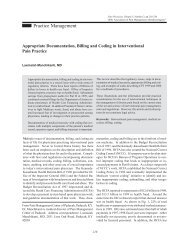ASIPP Practice Guidelines - Pain Physician
ASIPP Practice Guidelines - Pain Physician
ASIPP Practice Guidelines - Pain Physician
Create successful ePaper yourself
Turn your PDF publications into a flip-book with our unique Google optimized e-Paper software.
Manchikanti et al • <strong>ASIPP</strong> <strong>Practice</strong> <strong>Guidelines</strong><br />
58<br />
cluded that in both studies, the single-shot epidural perineural<br />
injection is effective in the treatment of lumbar radicular<br />
pain.<br />
Shah et al (623) compared the efficacy of fluoroscopically<br />
guided transforaminal epidurals for lumbar radiculopathy<br />
due to disc herniation with another group of patients who<br />
underwent trigger point injections in an office setting. Fifty<br />
patients were assessed with an average follow-up of 1.4<br />
years. Patients who had documented lumbar disc herniation<br />
on MRI, greater than 50% of the total pain present in<br />
the leg and/or buttock, at least 6 weeks of symptoms, and<br />
who failed to improve with oral medications and rehabilitation<br />
were included. They excluded patients with history<br />
of previous spinal surgery. Patients were randomly divided<br />
into two groups. Group I with 25 patients with average<br />
age of 41.3 years, received an average of 1.7 fluoroscopically<br />
guided transforaminal injections combined with home<br />
lumbar stabilization program and a back cryobrace. Group<br />
II with 23 patients with average age of 42.4 years received<br />
an average of 1.6 saline trigger point injections combined<br />
with home lumbar stabilization program and a back<br />
cryobrace. At three months, the nonresponders in group II<br />
were crossed into group I. The outcomes consisted of patient<br />
satisfaction rated from poor to excellent, pain score,<br />
Rolland-Morris questionnaire, and distance from finger to<br />
floor in centimeters collected pre-, and 3 weeks, 6 weeks,<br />
3 months, 6 months, and 1 year post-treatment. They defined<br />
a successful outcome as good or better satisfaction<br />
combined with greater than 50% reduction in pain score.<br />
The results showed that in Group I, average Rolland-Morris<br />
score was 8.8 pre- and 22.1 post-treatment, pain score<br />
was 8.8 pre- and 1.6 post-treatment, and distance from finger<br />
to floor was 69.6 cm pre- and 20.3 cm post-treatment.<br />
Overall, Group I had 84% successful outcome. Group II<br />
also showed significant improvement but only resulting in<br />
48% successful outcome. For Group II, the average<br />
Rolland-Morris score was 9.6 pre- and 18.3 post-treatment,<br />
pain score of 9.4 pre- and 3.6 post-treatment, and distance<br />
from finger to floor was 64.8 pre- and 24.4 post-treatment.<br />
Thus, Group I had a significantly better outcome than Group<br />
II at 1.4 year average follow-up (P>0.05). They also reported<br />
that the nonresponders who crossed over from Group<br />
II to Group I experienced 67% successful outcome. They<br />
reported that presence of spondylolisthesis, in addition to<br />
disc herniation, was a negative prognostic factor for Group<br />
I, whereas symptom duration greater than six months was<br />
a negative prognostic factor for Group II patients.<br />
Lutz et al (625) studied 69 patients in a prospective case<br />
series. They investigated the outcome of patients with lumbar<br />
herniated nucleus pulposus and radiculopathy using<br />
administration of fluoroscopically guided transforaminal<br />
epidural steroid injections. Patients were evaluated by an<br />
independent observer and were followed for an average<br />
period of 80 weeks, with a range of 28 to 144 weeks.<br />
Among the 69 patients, 75% of the patients had a successful<br />
long-term outcome, reporting at least a greater than 50%<br />
reduction between preinjection and postinjection pain<br />
scores, as well as an ability to return to or near their previous<br />
levels of functioning after 1.8 injections per patient<br />
(range, one to four injections). They concluded that fluoroscopic<br />
transforaminal epidural steroids are an effective<br />
nonsurgical treatment option for patients with lumbar herniated<br />
nucleus pulposus and radiculopathy in whom more<br />
conservative treatments are not effective.<br />
Bush and Hillier (571) described the response of 68 patients<br />
to cervical epidural steroid injections with some of<br />
them undergoing transforaminal epidural injections if they<br />
failed non- fluoroscopically guided lateral approach at C7.<br />
Following the first blind cervical epidural injection, if significant<br />
improvement was not seen, a repeat injection was<br />
performed transforaminally with fluoroscopic guidance<br />
within one month. Similarly, a third injection was also<br />
performed if needed in the same manner as the second injection.<br />
Overall, an average of 2.5 injections per patients<br />
was required for adequate pain control; 93% of the patients<br />
were reported to have good pain relief lasting for<br />
seven months.<br />
Weiner and Fraser (626) treated 28 patients with severe<br />
radiculopathy secondary to foraminal or extraforaminal<br />
herniation of lumbar disks. In these patients, the disk herniation<br />
was proven by imaging studies; and it failed to respond<br />
to rest and anti-inflammatory therapy, epidural injections,<br />
and physical therapy. The only remaining choice<br />
for these patients was surgical intervention due to the severity<br />
of pain and functional disability. The authors showed<br />
that 22 of the 28 patients improved dramatically, with sustained<br />
relief lasting an average of 3.4 years, with a range<br />
of 1 to 10 years. Further analysis showed that, of the 28<br />
patients, three obtained no relief and subsequently underwent<br />
diskectomy; but three obtained immediate relief and<br />
relapsed within 6 months. In addition, one patient obtained<br />
minimal relief but was able to tolerate continuing symptoms;<br />
and seven patients received moderate relief that allowed<br />
them to return to most activities but with caution<br />
and occasional symptomatic treatment. Of the 28 patients,<br />
14 had complete relief of their pain at follow-up that ranged<br />
from 1 to 10 years.<br />
<strong>Pain</strong> <strong>Physician</strong> Vol. 4, No. 1, 2001
















